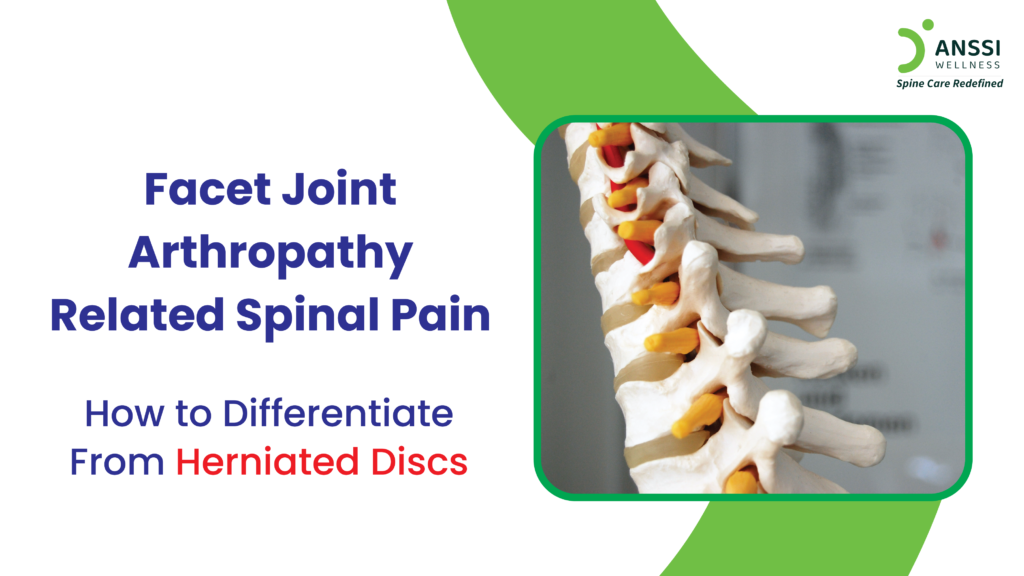Back pain is one of the most common reasons people seek medical help, especially among adults. Among its many causes, two significant contributors are facet joint arthropathy and herniated discs. While both can cause discomfort, stiffness, and restricted movement, their origins and treatments differ.
Accurate diagnosis and successful treatment of these two illnesses depend on an understanding of their differences.
What is Facet Joint Arthropathy?
Facet joints are small stabilising joints located at the back of the spine. They connect the vertebrae and help facilitate smooth movement of the spine. Facet Joint Arthropathy refers to the degeneration or inflammation of these joints. Over time, due to wear and tear, arthritis, injury, or ageing, these joints may become stiff, inflamed, or even develop bone spurs.
When facet joints deteriorate, they can cause localised back pain, particularly in the lower back (lumbar spine) or neck (cervical spine). This pain is typically worse in the morning, improves slightly with movement, and flares up with activities like arching the back, twisting, or standing for long periods.
What is a Herniated Disc?
The vertebrae that make up the spine are separated by intervertebral discs. These discs act as cushions, absorbing shock and maintaining flexibility. A herniated disc occurs when the soft inner gel-like material (nucleus pulposus) pushes through the tougher outer layer (annulus fibrosus), often pressing against nearby nerves.
Herniated discs can occur due to trauma, heavy lifting, ageing, or poor posture. Unlike facet joint pain, which remains mostly localised, disc-related pain often radiates. For example, a herniated disc in the lower back can cause sciatica—sharp, shooting pain down the leg.
Key Differences Between Facet Joint Arthropathy and Herniated Discs
Understanding the clinical differences between the two conditions can guide diagnosis and treatment:
Nature and Location of Pain:
- Facet Joint Arthropathy: Pain is typically localised to the area of the affected joint. It may feel like a dull ache and is commonly felt on one or both sides of the spine.
- Herniated Disc: Pain may start in the spine but radiates to other areas such as the arms or legs, depending on the location of the disc. Tingling, numbness, or weakness in limbs is common.
Movement-Related Pain:
- Facet Joint Arthropathy: Pain worsens when bending backwards (extension), twisting, or prolonged standing.
- Herniated Disc: Pain worsens with forward bending, sitting, coughing, or lifting heavy objects.
Associated Symptoms:
- Facet Joint Arthropathy: May cause stiffness, especially in the morning, but usually lacks nerve symptoms like numbness.
- Herniated Disc: Can cause nerve compression symptoms such as numbness, tingling, burning, or weakness in limbs.
Diagnostic Methods
To accurately distinguish between facet joint arthropathy and a herniated disc, physicians rely on several diagnostic tools:
1. Physical Examination:
A physician may test your range of motion, ask you to perform specific movements or check for signs of nerve involvement such as reflex loss, muscle weakness, or sensory changes.
2. Imaging Techniques:
- X-rays can help detect arthritis or bone changes in facet joints.
- MRI (Magnetic Resonance Imaging) is the gold standard for identifying herniated discs, nerve compression, and soft tissue details.
- CT scans may be used to get a detailed look at bone structures, especially for facet joints.
3. Diagnostic Injections:
For facet joint arthropathy, a diagnostic block (local anaesthetic injection) into the facet joint can help confirm the source of pain. If the pain significantly improves after the injection, the facet joint is likely the source.
Non-Surgical Treatments
Proper diagnosis allows the doctor to identify the most effective treatment path.
For Facet Joint Arthropathy:
- Physiotherapy: Exercises to strengthen the muscles around the spine, improve flexibility, and support the joints.
- Medications: Non-steroidal anti-inflammatory medicines, or NSAIDs, can aid in the reduction of pain and inflammation.
- Injections: Corticosteroid injections into the facet joints can provide temporary relief from inflammation and pain.
- Posture Correction: Proper sitting, standing, and sleeping posture reduces strain on the joints and improves spine alignment.
For Herniated Discs:
- Non-Surgical Spinal Decompression Treatment: A specialised, non-invasive procedure that gently stretches the spine using a motorised decompression table. This reduces pressure on the herniated disc, allowing it to retract and relieve nerve compression.
- Physiotherapy: Includes targeted exercises, stretches, and posture training to reduce symptoms and prevent recurrence.
- Lifestyle Changes: Maintaining a healthy weight, regular exercise, and avoiding activities that strain the back are essential for long-term relief.
By understanding the nature of your back pain and seeking timely medical evaluation, you can take the right steps toward a pain-free, active life.
About ANSSI:
ANSSI Wellness focuses on improving the quality of life for patients suffering from spinal issues, aiming to provide relief where other conventional treatments have failed. Through advanced non-surgical spinal decompression treatment, ANSSI is committed to helping patients avoid surgery and recover in a safe, effective, and compassionate environment.
Connect with ANSSI Wellness on LinkedIn, Instagram, and Facebook for expert guidance.



